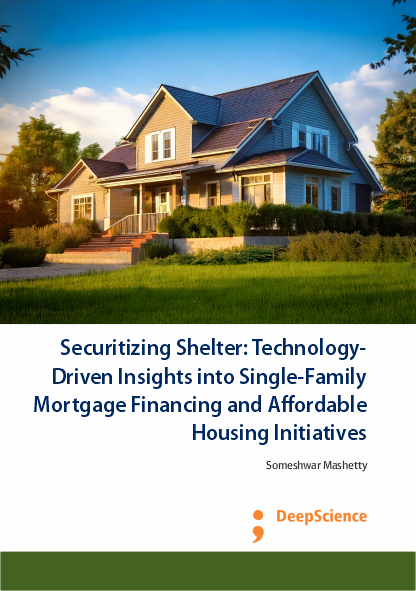Securitizing Shelter: Technology-Driven Insights into Single-Family Mortgage Financing and Affordable Housing Initiatives
Keywords:
Affordable Housing, Residential Lending, Mortgage Financing, Housing Policy, FinTech in Housing, Digital Mortgage Infrastructure, Finance, Machine Learning, Artificial Intelligence, Urban DevelopmentSynopsis
Housing is more than just shelter—it is the foundation of stability, opportunity, and economic mobility. Yet, achieving equitable access to affordable housing remains a persistent challenge in the modern era. Securitizing Shelter: Technology-Driven Insights into Single-Family Mortgage Financing and Affordable Housing Initiatives explores how cutting-edge technologies are reshaping the landscape of housing finance and policy. The intersection of finance, technology, and housing policy is undergoing rapid transformation. With the rise of data analytics, machine learning, and digital platforms, stakeholders now have unprecedented tools to assess risk, streamline mortgage origination, predict market trends, and design more effective affordable housing initiatives. Securitization, once viewed as a complex and opaque financial mechanism, is now being reimagined through transparent, tech-enhanced models that aim to balance profitability with social responsibility.
This book aims to illuminate the evolving role of technology in single-family mortgage financing—from automated underwriting systems to blockchain-enabled transparency—and how these innovations are impacting both lenders and borrowers. We also delve into the policy side, examining how data-driven insights can guide affordable housing programs, assess community needs, and shape inclusive urban development. Drawing on real-world examples, research findings, and industry trends, Securitizing Shelter offers a multifaceted view of how technology can be a powerful catalyst for positive change in the housing sector. It provides valuable insights for financial professionals, technologists, housing advocates, and policymakers alike. In a world where access to affordable housing is increasingly tied to digital infrastructure and financial innovation, this book invites readers to rethink what it means to provide shelter—and how smarter systems can help close the housing gap. By securitizing shelter through the lens of technology, we are not just financing homes—we are investing in the future of communities.
Chapters
-
Historical evolution of residential lending structures and the rise of financial innovation
-
Regulatory frameworks shaping modern lending practices in the residential sector
-
Digital infrastructure and its influence on streamlining home lending workflows
-
Private sector approaches to expanding access to stable living
-
The role of predictive modeling in assessing borrower risk and loan performance
-
Cross-Sector collaborations for expanding equitable access to long-term housing stability
-
Economic incentives and investment strategies for revitalizing under-served neighborhoods
-
Machine learning applications in enhancing loan-level transparency and decision-making
-
Balancing profitability and social responsibility in urban development financing
-
Public-private partnership models for enhancing built environment sustainability
-
Geo-spatial data and its applications in identifying community revitalization opportunities
-
Future-proofing residential lending through responsible innovation and data governance












